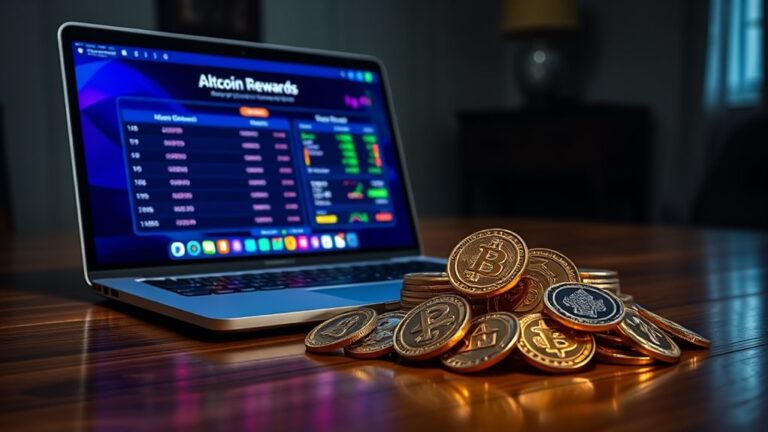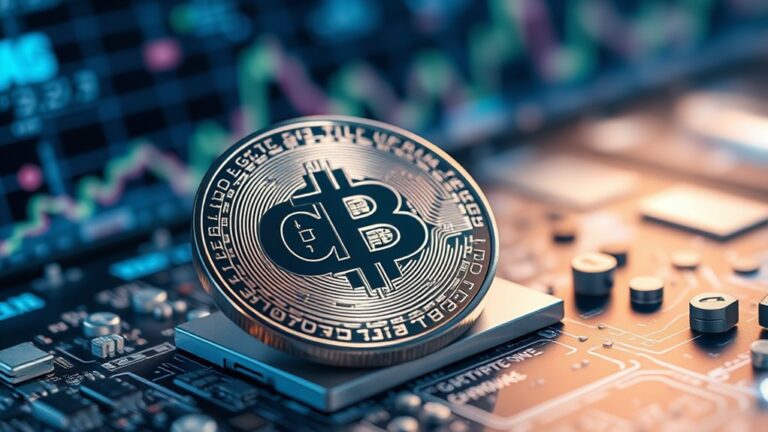
Altcoin Market Trends and Predictions: Top Contenders for 2025
The altcoin market in 2025 will likely be influenced by regulatory clarity and technological advancements. Increasing institutional involvement and macroeconomic factors also play a significant role in shaping its dynamics. Key contenders include stablecoins, benefiting from clearer regulations, and innovative projects integrating AI and blockchain. Market trends suggest a rise in altcoin dominance, favored by technological solutions like cross-chain compatibility and scalable blockchain models. This evolving landscape offers numerous opportunities for investors seeking to understand future possibilities.
Key Takeaways
- Rising altcoin dominance signals potential contenders with increased market capitalization relative to Bitcoin.
- Institutional involvement boosts altcoin credibility and adoption, influencing future market trends.
- Regulatory clarity enhances investment confidence, supporting the growth of top altcoins by 2025.
- Technological advancements like AI and blockchain modularization drive altcoin innovation and adoption.
- Stablecoins' role in DeFi and payments integration benefits from clearer regulations, attracting institutional interest.
Indicators of an Altcoin Season
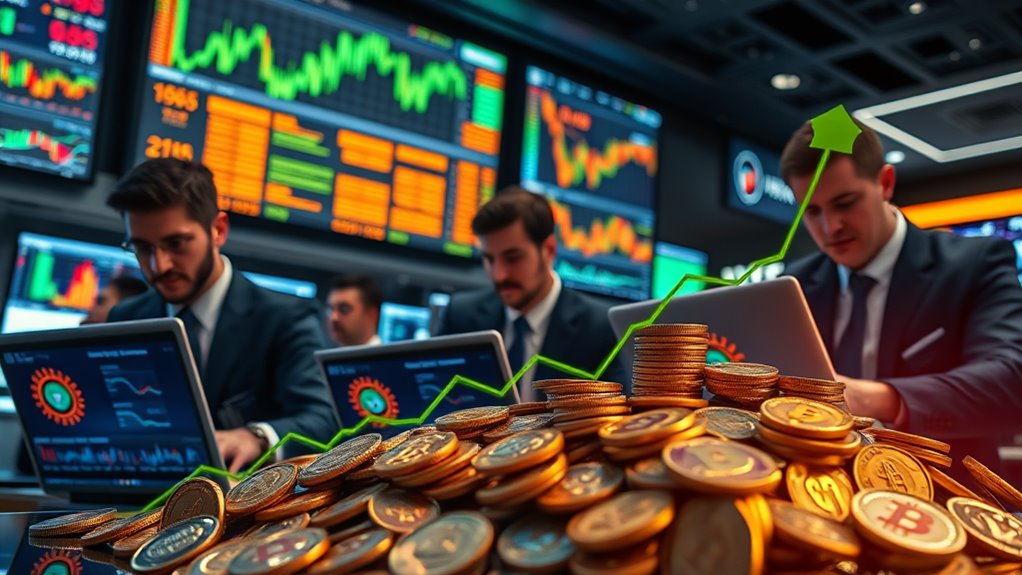
In the world of cryptocurrencies, understanding the indicators of an altcoin season is essential for investors seeking to maximize their returns. A significant factor is the rise in altcoin dominance, marked by an increase in their market capitalization relative to Bitcoin.
This often coincides with a shift in investor focus from Bitcoin to alternative cryptocurrencies. As a result, Bitcoin's dominance as a percentage of the total crypto market tends to decrease.
An increase in the altcoin season index can signal potential opportunities for investors. Additionally, the phenomenon known as FOMO, or fear of missing out, often leads to increased investments in altcoins as their prices rise.
With the growing interest in decentralized finance, the DeFi growth could further drive the altcoin market, presenting investors with new opportunities and challenges.
These indicators help investors identify favorable conditions for altcoin investments.
Key Drivers Influencing Altcoin Performance

Regulatory clarity plays a pivotal role in shaping altcoin performance, as favorable regulations can enhance investor confidence and market stability. Institutional involvement has been increasing, with more financial entities recognizing the potential of altcoins, which boosts their credibility and adoption rates. Additionally, macro-economic conditions, such as interest rates and inflation, can influence investor behavior and the overall demand for altcoins in the market. Thoughtful regulation may legitimize cryptocurrencies by ensuring they are not used in illicit activities, potentially fostering mainstream adoption and sustainable growth in the digital asset ecosystem.
Regulatory Clarity Impact
Clarity in regulation serves as a cornerstone for the advancement of the altcoin market. The economic impact of regulatory clarity is profound, providing a structured environment that enhances adoption.
Key benefits include:
- Investment Confidence: Clear regulations boost investor confidence, encouraging more investments in altcoins.
- Risk Mitigation: Well-defined laws help mitigate risks like money laundering and fraud.
- Market Sentiment: Positive regulatory developments improve market sentiment, supporting growth.
- Global Market Integration: Uniform regulations facilitate the integration of altcoins into the global market.
Technological advances are also influenced by regulatory clarity, accelerating blockchain innovations and AI integration. Additionally, it fosters the development of security features and smart contracts. A noteworthy trend is the integration with DeFi platforms, which can further drive the mainstream acceptance of altcoins beyond speculative investment.
Institutional Involvement Trends
As regulatory clarity strengthens the foundation of the altcoin market, the role of institutional involvement emerges as a key driver influencing its performance.
Institutional investment in cryptocurrencies is experiencing significant growth, with major players such as BlackRock and Fidelity integrating digital assets into their portfolios. This integration boosts market liquidity, offering a more stable and attractive environment for retail investors.
The influx of capital from these institutions is expected to enhance liquidity, allowing for better global market reach and the development of specialized trading platforms.
Additionally, the exploration of tokenized assets and stablecoins by institutions aligns with advancements in blockchain technology, further stabilizing the market.
As institutions diversify their investments, the untapped potential of altcoins gains attention, signaling promising growth opportunities.
Furthermore, alternative Layer 1 blockchains such as Solana, Avalanche, Cardano, and Polkadot are gaining traction due to their unique technological advantages, scalability, and ecosystem growth, making them attractive options for institutional investors.
Macro-Economic Conditions Influence
The altcoin market is markedly influenced by macroeconomic conditions, which play an integral role in determining its performance. Various factors shape the landscape:
- Inflation Impact: Lower inflation rates can lead to interest rate cuts, increasing liquidity in risk assets like altcoins. This can potentially fuel market rallies.
- Interest Rate Dynamics: Changes in interest rates greatly affect altcoin performance. Lower rates often drive capital towards these assets, enhancing their appeal.
- Regulatory Environment: Clear regulations can boost investor confidence, encouraging altcoin adoption. Regulatory clarity is vital for market stability.
- Geopolitical Events: Tensions and policies can influence market sentiment. For example, economic sanctions and trade policies might alter investor behavior regarding altcoins.
It's important to note that the altcoin market is fraught with risks such as extreme price volatility and regulatory uncertainties, which investors must navigate with thorough research and risk management strategies.
Understanding these factors is vital for those evaluating altcoin market trends and predictions.
Top Altcoin Contenders for 2025
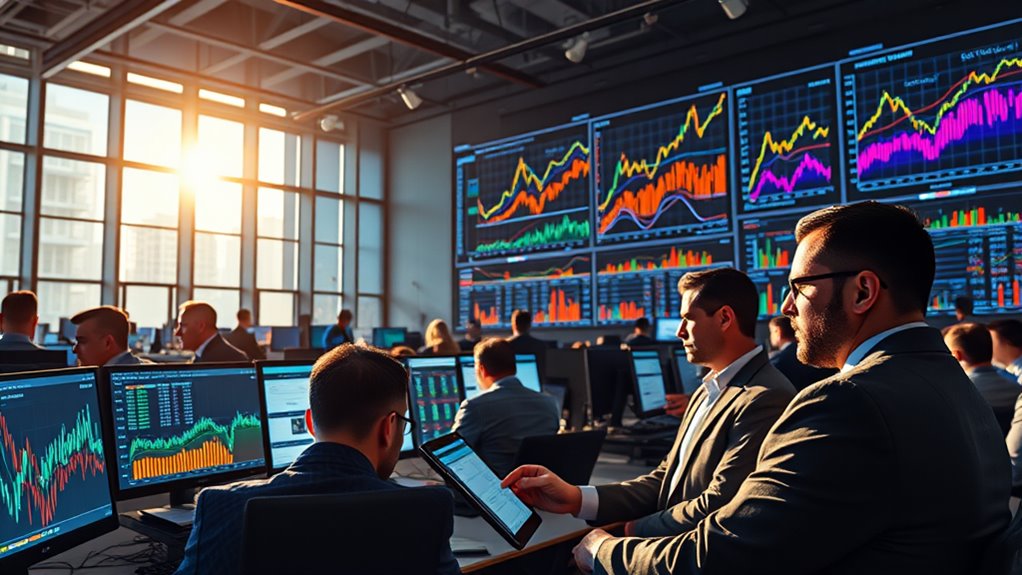
Solana has gained attention as a top contender for 2025 due to its impressive scalability, which allows for fast and efficient transactions, attracting developers and projects to its ecosystem. Meanwhile, Cardano's efforts to integrate with banking systems could enhance its adoption, potentially boosting its position in the financial sector. Both of these altcoins demonstrate qualities that may contribute to their continued prominence in the evolving cryptocurrency market. Additionally, investors are keeping an eye on technological innovations and real-world applications as critical factors influencing the potential success of altcoins beyond Bitcoin.
Solana's Scalability Impact
While Solana's remarkable growth in the crypto market is undeniable, its scalability advancements set it apart as a top contender among altcoins for 2025. This is largely due to several cutting-edge technologies and strategies.
To begin with, Solana is exploring sharding, which allows data to be split, enhancing parallel transaction processing. In addition, the integration of SuperSol introduces Evanescent Rollups, which improve scalability without overloading the main network.
Furthermore, the Sealevel Execution Engine boosts transaction throughput by enabling parallel execution. Finally, state compression advancements reduce on-chain data storage costs, benefiting NFTs and tokenized assets.
These innovations not only improve transaction speed and efficiency but also attract developers, positioning Solana as a formidable player in the altcoin market. Solana's exploration of Layer 2 solutions, similar to popular Layer 2 technologies like rollups, sidechains, and state channels, further enhances its scalability and appeal in the cryptocurrency ecosystem.
Cardano's Banking Integration
Many factors contribute to Cardano's growing influence in the altcoin market, particularly its efforts to integrate with traditional banking systems. Cardano's collaboration with AMINA Bank, which offers staking services, marks a notable milestone in bridging decentralized finance with traditional banking. This integration provides mainstream investors an opportunity to stake ADA through a recognized financial institution, mitigating self-custody risks. By enhancing ADA's appeal to conservative investors, staking participation is expected to rise, impacting its market dynamics by potentially reducing the circulating supply, thereby stabilizing prices. Institutional recognition of ADA, bolstered by its proof-of-stake model, emphasizes its sustainable and environmentally friendly nature. This recognition is likely to encourage broader adoption, paving the way for increased institutional engagement and future integration efforts. Understanding white papers is crucial for investors to comprehend the underlying technology and vision of altcoins like Cardano, further aiding informed investment decisions.
Macroeconomic Impact on Altcoins

Macroeconomic factors play a significant role in shaping the altcoin market, influencing its growth and stability. Several key elements impact the market dynamics:
- Inflation and Interest Rates: Lower inflation and interest rate cuts by central banks can lead to increased liquidity in riskier assets like altcoins, boosting growth.
- Global Economic Stability: Economic volatility might push investors towards alternative assets, benefiting altcoins, whereas a recession could deter investment.
- Regulatory Landscape: Clear, favorable regulations can enhance investor confidence, driving altcoin growth, while strict policies may have the opposite effect.
- Institutional Involvement: Rising participation from institutional investors, through dedicated funds and ETFs, can provide stability to altcoin markets.
Additionally, technological innovations that altcoins bring to the blockchain space can also significantly influence their adoption and market trends. Understanding these macroeconomic influences helps predict potential trends in the altcoin market.
Technological Trends Shaping Altcoin Markets
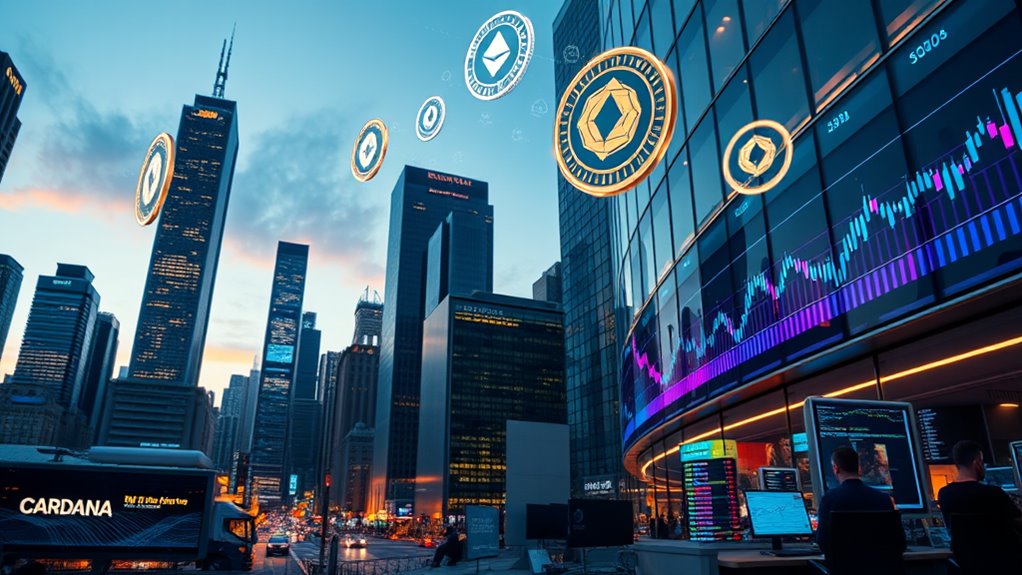
Technological advancements are profoundly shaping the altcoin markets, introducing both innovations and challenges. Scalability solutions, such as Ethereum's Layer-2 options like Arbitrum and Optimism, address network congestion, enhancing transaction efficiency.
AI integration is notable, with projects like Fetch.ai and SingularityNET pioneering decentralized AI networks. Blockchain modularization offers alternatives through platforms like Celestia, which diverge from traditional models. Smart contract efficiency is improving with AI, optimizing their autonomy and functionality.
In decentralized data management, Ocean Protocol stands out for secure data exchanges. Solana's speed is challenging Ethereum's dominance, while Ethereum's Dencun upgrade focuses on transaction improvements.
Cross-chain compatibility, led by Cosmos, facilitates seamless blockchain communication. Ultimately, stablecoins are pivotal in DeFi and global payments, integrating with traditional financial systems.
Ethereum's transition from proof-of-work to proof-of-stake with "The Merge" signifies a major shift in its consensus mechanism, enhancing energy efficiency and scalability.
Institutional Involvement and Adoption

While technological advancements continue to reshape the altcoin markets, the involvement of institutional investors is increasingly influencing the broader cryptocurrency landscape. Major financial entities like MicroStrategy and Fidelity are integrating cryptocurrencies into their investment portfolios. This shift is driven by several factors:
- Institutional Investment Growth: Increased market liquidity from institutional capital enhances trading environments for retail investors.
- Adoption by Financial Giants: Companies like BlackRock are launching tokenized funds, blending traditional finance with blockchain.
- Regulatory Environment Impact: Clearer regulations are poised to attract more institutional investors, as seen with Bitcoin ETF approvals.
- Institutional Investment Strategies: Cryptocurrencies are used for diversification and risk management, with Bitcoin emerging as a strategic reserve asset.
These developments indicate a robust trend towards broader institutional adoption and integration into the crypto space.
Frequently Asked Questions
How Do I Choose the Best Altcoin to Invest In?
Choosing the best altcoin involves evaluating real-world use cases, development teams, community support, and market trends. Consider blockchain scalability, innovation, partnerships, and regulatory environment. Diversification and risk management strategies are essential for informed investment decisions.
What Are the Risks of Investing in Altcoins?
Investing in altcoins involves risks such as high price volatility, security threats from hacking, and legal uncertainties due to evolving regulations. Additionally, market sentiment shifts and speculative nature contribute to unpredictable investment outcomes, challenging investor decisions.
How Does Blockchain Scalability Affect Altcoin Prices?
Blockchain scalability, the golden goose of cryptocurrency, can influence altcoin valuations through reduced transaction fees and enhanced user experiences, fostering broader adoption. However, balancing decentralization, security, and scalability remains a complex endeavor impacting market confidence.
Can Altcoins Replace Bitcoin as the Dominant Cryptocurrency?
Altcoins possess the potential to surpass Bitcoin's dominance, though hurdles such as regulatory clarity, market volatility, and institutional interest must be addressed. Success hinges on innovation, liquidity, and global economic stability to foster widespread adoption and market leadership.
How Do Geopolitical Events Influence Altcoin Markets?
In a rapidly shifting global landscape, geopolitical events cast long shadows over altcoin markets. Economic sanctions, regulatory changes, and conflicts stir uncertainty, driving investors towards decentralized assets. This volatility hints at both peril and opportunity for discerning investors.
Conclusion
As the altcoin market navigates toward 2025, the irony lies in how these digital assets, once dismissed as mere novelties, are now serious contenders in the financial world. Indicators of an altcoin season, coupled with macroeconomic influences and technological advancements, suggest a dynamic future. Yet, while institutional adoption grows, the market's inherent volatility remains a sobering reminder. Consequently, those examining altcoin potentials must balance optimism with caution, recognizing the unpredictable nature of this evolving landscape.





